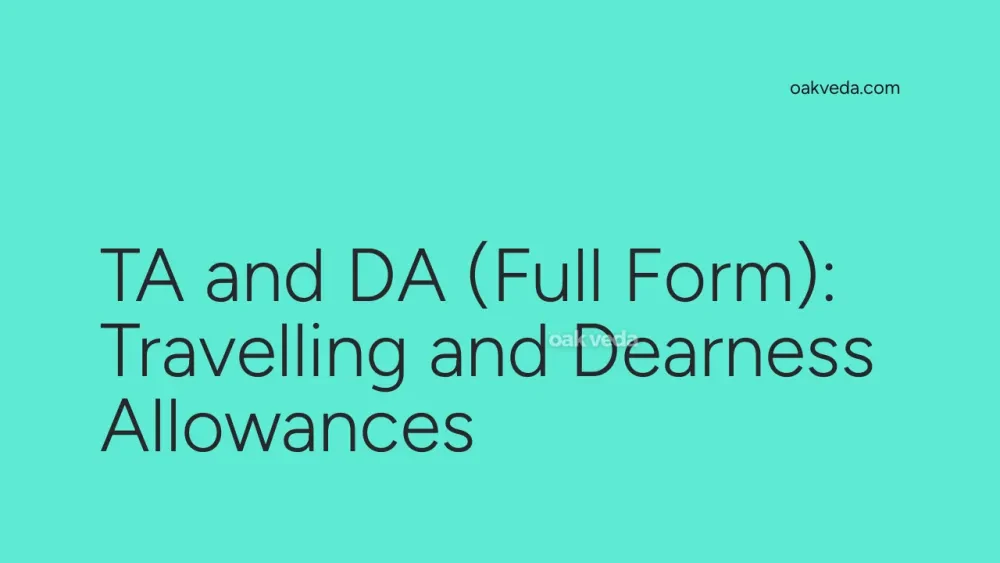
What is the Full Form of TA and DA?
The full form of TA is Travelling Allowance, while DA stands for Dearness Allowance. These two terms are commonly used in the context of employee compensation, particularly in India, Pakistan, and Bangladesh. Both TA and DA are crucial components of an employee's salary structure, designed to cover specific expenses and maintain the standard of living.
What is Travelling Allowance (TA)?
Travelling Allowance, or TA, is a financial benefit provided by employers to cover expenses incurred by employees during business-related travel. This allowance is intended to reimburse costs associated with transportation, accommodation, meals, and other incidental expenses that arise when an employee travels for work purposes.
How does Travelling Allowance work?
The implementation of Travelling Allowance can vary depending on the organization's policies. Generally, there are two main approaches:
- Fixed TA: Some companies offer a fixed monthly travel allowance, regardless of actual travel undertaken.
- Reimbursement-based TA: Other organizations require employees to submit receipts and claim reimbursement for actual expenses incurred during business trips.
Types of Travelling Allowance
Travelling Allowance can be categorized into several types:
- Daily Allowance: A fixed amount provided per day of travel
- Mileage Allowance: Reimbursement based on the distance traveled
- Conveyance Allowance: Covers local transportation costs
- Lodging Allowance: Specifically for accommodation expenses
Benefits of Travelling Allowance
- Ensures employees are not out of pocket for work-related travel expenses
- Encourages employees to undertake necessary business travel
- Can be a tax-efficient component of salary structure in some cases
Limitations of Travelling Allowance
- Often subject to caps or limits set by the employer
- May require extensive documentation for reimbursement
- Can be misused if not properly monitored
What is Dearness Allowance (DA)?
Dearness Allowance, or DA, is a cost of living adjustment payment made to government employees, public sector employees, and pensioners in India, Pakistan, and Bangladesh. It is calculated as a percentage of an employee's basic salary and is designed to mitigate the impact of inflation on the purchasing power of salaries.
Origin and Development of Dearness Allowance
The concept of Dearness Allowance was introduced in India during World War II when the cost of living rose sharply due to wartime inflation. Since then, it has become an integral part of the compensation structure in the public sector and many private organizations.
How does Dearness Allowance work?
DA is typically calculated as a percentage of the basic salary. This percentage is periodically revised by the government based on the Consumer Price Index (CPI), which measures changes in the price level of consumer goods and services.
Functions of Dearness Allowance
- Inflation Protection: DA helps maintain the real value of salaries in the face of rising prices.
- Standardization: It provides a uniform method for adjusting salaries across different government departments and public sector units.
- Economic Indicator: Changes in DA rates can be used as an indicator of inflation trends in the economy.
Benefits of Dearness Allowance
- Helps employees maintain their standard of living despite inflation
- Provides a systematic way to adjust salaries in line with economic conditions
- Often forms a significant portion of the total salary, especially for government employees
Challenges of Dearness Allowance
- Can put pressure on government finances during periods of high inflation
- May not always keep pace with actual increases in the cost of living
- Differences in DA rates between central and state governments can lead to disparities
Future Developments in Allowance Systems
As the nature of work evolves, particularly with the rise of remote work and gig economy, allowance systems may need to adapt. Future developments could include:
- More flexible TA systems to accommodate diverse work arrangements
- Integration of technology for easier expense tracking and reimbursement
- Potential reforms in DA calculation methods to better reflect regional cost differences
FAQs on TA and DA Full Form
-
Is TA taxable in India? The taxability of TA depends on whether it's a fixed allowance or reimbursement. Fixed allowances are generally taxable, while reimbursements against actual expenses are often tax-free up to certain limits.
-
How often is DA revised? In India, DA is typically revised twice a year, usually in January and July, based on the latest CPI data.
-
Do private companies provide DA? While DA is mandatory for government employees, private companies may choose to include it in their salary structure or provide similar inflation-adjusted components.
-
Can TA be claimed for local travel? This depends on the company's policy. Some organizations provide a separate conveyance allowance for local travel, while others may include it in the TA.
-
Is DA applicable to pensioners? Yes, in India, pensioners also receive DA to help maintain the value of their pension in the face of inflation.
Understanding the full form and implications of TA and DA is crucial for both employers and employees. These allowances play a significant role in ensuring fair compensation and maintaining employee welfare in the face of economic changes.
You may be interested in:
- UV (Ultraviolet): Full Form, Types, and Applications
- RAW (Research and Analysis Wing): India's Intelligence Agency
- INR (Indian Rupee): Full Form and Comprehensive Guide
- IMF (International Monetary Fund): Full Form Explained
- MS (Full Form): Master of Surgery, Science, and Microsoft
- IVF (In Vitro Fertilization): Full Form and Explained

